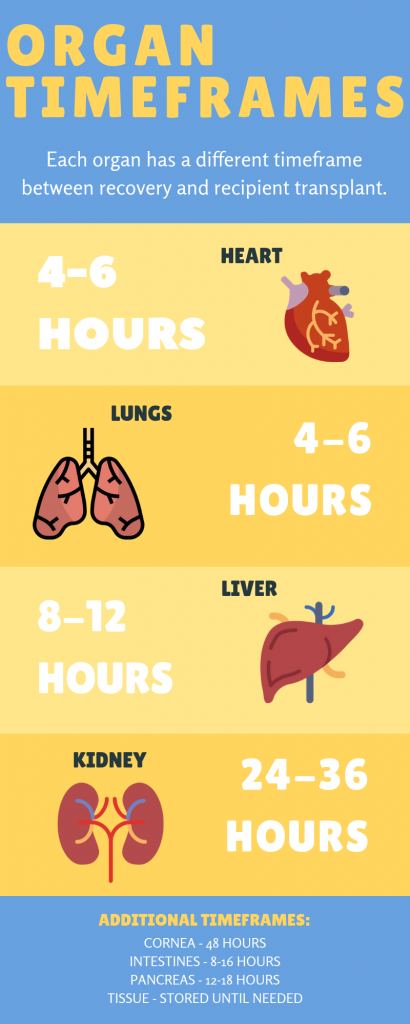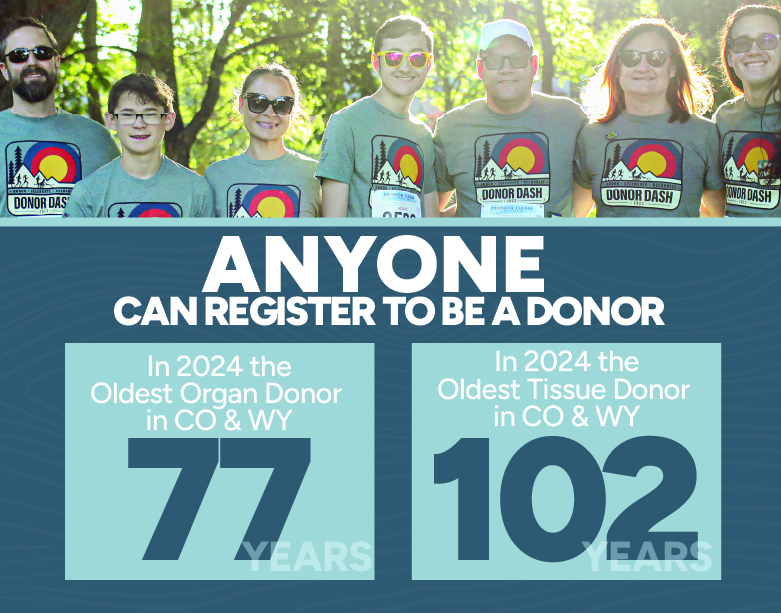Donation Essentials Blog
What is the Time Frame for Transplanting Organs?

Organ, Eye and Tissue Donation Saves Lives
The lifesaving benefits of organ donation and transplantation are widely known and accepted. Many don’t realize how critical and complex the time frame for transplanting organs from donor to recipient can be. If you’re wondering how long organs are viable after death, the short answer is – that it depends.
The United Network for Organ Sharing Sets Allocation Policy
The United Network for Organ Sharing (UNOS), is the national organization that sets allocation policies and matches donors to recipients. The UNOS allocation criteria is a combination of donor and transplant candidate medical data —including blood type, height, and weight, how long the patient has been waiting, medical urgency, etc.— and the location of the transplant and donor hospitals.
The UNOS Allocation Criteria Accounts for the Medical Complexity of Each Organ
Thanks to advances in medical technology, recovered organs can be transported hundreds, or even thousands of miles to give the gift of life to recipients in need. However, each organ is different, so the UNOS allocation criteria is unique to account for the medical complexity of each organ. For example, thoracic organs, like the heart and lungs, can only remain viable for transplant after being outside the body for four to six hours, while the liver can function for up to 12 hours and kidneys for up to 36 hours. Therefore, the location of the donor and the potential recipient is more critical for matching hearts and lungs than it is for kidneys or livers.
How long do organs remain viable after death, and how are they matched to a recipient?
The Heart: 4-6 hours
In addition to medical urgency, blood type, and other biological factors, those waiting for a heart transplant are also matched based on location because of the critical timing for this organ. The heart is only viable for 4-6 hours. Body size is also significant in heart matching, as the donor’s heart must fit comfortably inside the recipient’s ribcage.
The Lungs: 4-6 hours
Similar to heart matching, location and body size are important considerations in lung allocation since the lungs are viable 4-6 hours after donation. That information is combined with the above criteria to determine a donor recipient.
The Liver: 8-12 hours
Candidates who need a liver transplant are assigned a MELD or PELD score (Model for End-Stage Liver Disease or Pediatric End-Stage Liver Disease) that indicates how urgently they need the organ. A donor liver is offered first to the candidate who matches the common matching criteria and has the highest MELD or PELD score. Location is also taken into consideration, but since the liver can function for a longer time (8-12 hours) outside of the body, it is able to travel farther than the heart and lungs.
The Kidneys: 24-36 hours
Kidney allocation is heavily influenced by waiting time or how long the recipient has been listed for transplant. Fortunately, there is a bridge treatment for many in end-stage renal disease, called dialysis, which allows candidates to survive while awaiting a transplant. In addition, blood type, other biological factors, as well as the body size of the donor and recipient are always key factors. Medical urgency and location are also factors but less so than other organs, as the kidney can remain viable outside the body for 24-36 hours under the proper conditions.
The Waiting List Ensures Organs are Allocated within Constricted Time Frames
The waiting list is not simply a list of people who are eligible for transplant. It’s a dynamic, complex algorithm based on a carefully developed policy that ensures scarce organs are allocated to recipients as fairly and accurately as possible within highly constricted time frames. Learn more about the waiting list and how patients are added here.
For more questions about the organ donation process, visit the Donor Alliance About Donation page. If you are interested in signing up to become a donor at the time of your death, visit DonateLifeColorado.org or DonateLifeWyoming.org.


